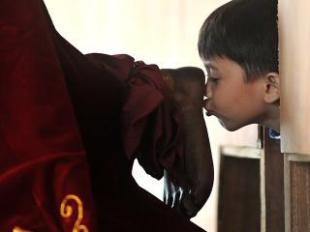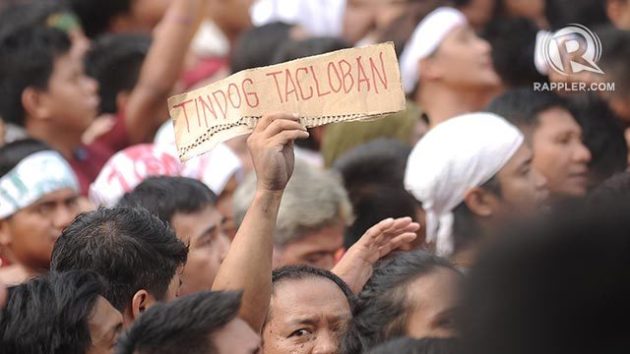As a non-affiliated person, I’ve always looked at the Feast of the Black Nazarene with both fear and awe. The frentic, fanatic storm surge of human bodies, charged with testosterone, drive a statue to and fro, inching forward in its traditional procession route. It looks like a tiny boat, manned by brave men in yellow, carried along by a rip current of Filipino bodies.
photo credit: inquirer.net
Every year, the image of the Black Nazarene is dressed up for the traditional Pahalik, or Kissing of the Feet. Devotees of this practice believe that kissing the foot or cross of Jesus is miraculous. The line stretches for about a mile, with much assistance for the disabled and the sick.
photo credit: GMA News
The following day, January 9th, Poong Nazareno, comes down from its gilded glass box in Quiapo Church to join the masses in a procession around Manila. In 2012, the circuit went on for more than 24 hours. Along the dirty and pockmarked streets of Manila, the god of the masses is mobbed and carried along.
This is not the hopeful thanksgiving to the smiling baby Jesus Sto. Nino. This is not your happy fiesta, like the Sinulog Festival in Cebu where people offer dances, colorful costumes and harvested local goods. The sight of a wretched 9 million marching and chanting “Viva! Viva! Viva Señor Nazareno!” is frightening.
The devotees not only join the image around the procession. The main goal is to touch the icon for the ultimate blessing: prosperity, wellness, hope. Hey, you can even take home the after effect of this blessing by touching it with a humble Good Morning Towel. The towelette touched by the Nazareno, they say, can cure any disease.
Whether it is a good or bad thing will not be debated here. I also wouldn’t want to put the focus on those who attend for the sake of peer pressure and “trip lang” (“just because”). A lot has already been said about the dangers and plain craziness of the feast. I may not necessarily agree with this show of faith but I respect other people’s beliefs.
My fascination is on the symbolism of the image of the Black Nazarene and its effect to the faithful. My favorite analysis is from GMA7’s Jessica Soho. She says that the Black Nazarene is the best Jesus for the Filipinos. It is dark skinned, like us. It carries a burden, like us. It is down on one knee, just like us.
photo credit: inquirer.net
Sure, Filipinos adore the Virgin Mary, pure, gentle, smiling, wrapped in a soft silk veil, her skin often white. We offer her flowers, candles and dances. But we hardly go to such great lengths to touch her, kiss her, wipe her skin with our towelettes.
Such physical devotion is reserved only for the god of the masses. A down and out probinsyano who has left his farm, sold his carabao, only to end up selling cigarettes and gum on the street can see his brown skin and pained expression on the image. An underpaid security guard tied to an unstable job longs to be free as he sees the chain around the neck of Jesus. A young mother with an ailing son wishes for the strength in those shoulders burdened by the cross.
How people cross the sea of bodies is a miracle in itself. The Hijos de Nazareno, bodyguards of the Nazarene, ensure that people get their due blessings, carry the image on their shoulders and keep the procession going. Anyone who needs help getting close to the icon need only shout “Kapatid! Tulong!” (Brother! Help!) and fellow devotees would carry you up on their shoulders. They don’t mind if you step on them. It is part of their panata, their promise of service to their god.
The Hijos de Nazareno are mostly men from Manila. Quiapo itself is notorious for street hawkers, fortune tellers, poverty, crime and urban filth. It needs the right kind of god to keep it alive. Some of the devotees are former barumbados, gangsters and ex-convicts, who found redemption in caring for the image. Some of them extend their devotion to the day-to-day maintenance of a four hundred year old wooden statue.
There seems to be unwritten honor code within the mayhem of the procession. People attend barefoot. Not only does this symbolize sacrifice, but also to avoid hurting others by stepping on toes. Personal space is unheard of. You are expected to keep a cool head in the heat and bustle of the mega-crowd. If somebody faints from heat and exhaustion, they are carried by the crowd to safety. This year, more than 1,600 fell ill or were injured in the procession. It is as dangerous as a frenzied rock concert but a stampede has not been recorded in the two hundred years of this tradition. There is an strange sense of brotherhood in the hustle and bustle, an orderly sort of chaos.
Another miracle of sorts is the hundreds of towelettes tossed up to the image. The Hijos De Nazareno manning the platform will catch the hankies, wipe the image with them and toss them back into the crowd. One merely has to watch and wait patiently as the towel is carried passed back to you by many many hands. It is bad form to steal somebody else’s towelette. After all, how could a stolen blessing be effective?
This show of great community and great faith is also an unsettling reminder of the desperate state of our nation. The Sinulog says “Let’s have fun. Thanks be to God.” The phenomenon in Quiapo says “God help us!” No wonder that 9 million attended this year. I’m guessing that some of them come straight from typhoon or earthquake stricken provinces like Bohol, Leyte and Samar.
Indeed, if this is a god who steps down among its people, carries their burden along with them, surely, he can also carry the prayers of the Filipino people. I think the most important lesson of the Black Nazareno is that it is an image of a god, trying to stand up even after falling. More than just praying, wiping towels and joining processions, we Filipinos pick up our cross, be strong, and rise again.
Thanks to rappler.com, inquirer.net and gmanetwork.com/news/ for data and images.





